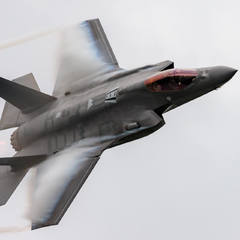-
Posts
511 -
Joined
-
Last visited
Reputation Activity
-
 ThePointblank got a reaction from Skipple in My Sponsor says Slower is… Better?
ThePointblank got a reaction from Skipple in My Sponsor says Slower is… Better?
As someone who owns a 2023 G14, the MediaTek WiFi card is at best, hot garbage. Many users I've seen on Reddit swap the card out for an Intel card for better performance and consistency.
-
 ThePointblank got a reaction from snappercayt in Nvidia Boosts Hardware Video Encoding Performance For Some Consumer GPU's
ThePointblank got a reaction from snappercayt in Nvidia Boosts Hardware Video Encoding Performance For Some Consumer GPU's
Tom's Hardware recently noticed that in a recent update to an Nvidia support page, a number of consumer GPU's have had their video encoding performance improved, from only being able to encode 3 video streams to now 5 concurrently:
https://www.tomshardware.com/news/nvidia-increases-concurrent-nvenc-sessions-on-consumer-gpus
Quotes
There is no change that affects the number of NVENC and NVDEC hardware units activated in Nvidia's consumer GPU's; the capability was always in the silicon, but was disabled in software, while Nvidia's workstation and data center focused GPU's technically could support 11–17 concurrent NVENC sessions depending on the quality and hardware.
It appears Nvidia has changed their stance and reduced the cripple hammer on hardware video encoding, and this should be positive news for people with a lower budget and want a video editing workstation or those working on a laptop, as depending on their needs, may no longer need a workstation GPU to multiple concurrent encodes.
-
 ThePointblank got a reaction from Taf the Ghost in Nvidia Boosts Hardware Video Encoding Performance For Some Consumer GPU's
ThePointblank got a reaction from Taf the Ghost in Nvidia Boosts Hardware Video Encoding Performance For Some Consumer GPU's
Tom's Hardware recently noticed that in a recent update to an Nvidia support page, a number of consumer GPU's have had their video encoding performance improved, from only being able to encode 3 video streams to now 5 concurrently:
https://www.tomshardware.com/news/nvidia-increases-concurrent-nvenc-sessions-on-consumer-gpus
Quotes
There is no change that affects the number of NVENC and NVDEC hardware units activated in Nvidia's consumer GPU's; the capability was always in the silicon, but was disabled in software, while Nvidia's workstation and data center focused GPU's technically could support 11–17 concurrent NVENC sessions depending on the quality and hardware.
It appears Nvidia has changed their stance and reduced the cripple hammer on hardware video encoding, and this should be positive news for people with a lower budget and want a video editing workstation or those working on a laptop, as depending on their needs, may no longer need a workstation GPU to multiple concurrent encodes.
-
 ThePointblank got a reaction from leadeater in Nvidia Boosts Hardware Video Encoding Performance For Some Consumer GPU's
ThePointblank got a reaction from leadeater in Nvidia Boosts Hardware Video Encoding Performance For Some Consumer GPU's
Tom's Hardware recently noticed that in a recent update to an Nvidia support page, a number of consumer GPU's have had their video encoding performance improved, from only being able to encode 3 video streams to now 5 concurrently:
https://www.tomshardware.com/news/nvidia-increases-concurrent-nvenc-sessions-on-consumer-gpus
Quotes
There is no change that affects the number of NVENC and NVDEC hardware units activated in Nvidia's consumer GPU's; the capability was always in the silicon, but was disabled in software, while Nvidia's workstation and data center focused GPU's technically could support 11–17 concurrent NVENC sessions depending on the quality and hardware.
It appears Nvidia has changed their stance and reduced the cripple hammer on hardware video encoding, and this should be positive news for people with a lower budget and want a video editing workstation or those working on a laptop, as depending on their needs, may no longer need a workstation GPU to multiple concurrent encodes.
-
 ThePointblank got a reaction from da na in Nvidia Boosts Hardware Video Encoding Performance For Some Consumer GPU's
ThePointblank got a reaction from da na in Nvidia Boosts Hardware Video Encoding Performance For Some Consumer GPU's
Tom's Hardware recently noticed that in a recent update to an Nvidia support page, a number of consumer GPU's have had their video encoding performance improved, from only being able to encode 3 video streams to now 5 concurrently:
https://www.tomshardware.com/news/nvidia-increases-concurrent-nvenc-sessions-on-consumer-gpus
Quotes
There is no change that affects the number of NVENC and NVDEC hardware units activated in Nvidia's consumer GPU's; the capability was always in the silicon, but was disabled in software, while Nvidia's workstation and data center focused GPU's technically could support 11–17 concurrent NVENC sessions depending on the quality and hardware.
It appears Nvidia has changed their stance and reduced the cripple hammer on hardware video encoding, and this should be positive news for people with a lower budget and want a video editing workstation or those working on a laptop, as depending on their needs, may no longer need a workstation GPU to multiple concurrent encodes.
-
 ThePointblank got a reaction from GuiltySpark_ in Nvidia Boosts Hardware Video Encoding Performance For Some Consumer GPU's
ThePointblank got a reaction from GuiltySpark_ in Nvidia Boosts Hardware Video Encoding Performance For Some Consumer GPU's
Tom's Hardware recently noticed that in a recent update to an Nvidia support page, a number of consumer GPU's have had their video encoding performance improved, from only being able to encode 3 video streams to now 5 concurrently:
https://www.tomshardware.com/news/nvidia-increases-concurrent-nvenc-sessions-on-consumer-gpus
Quotes
There is no change that affects the number of NVENC and NVDEC hardware units activated in Nvidia's consumer GPU's; the capability was always in the silicon, but was disabled in software, while Nvidia's workstation and data center focused GPU's technically could support 11–17 concurrent NVENC sessions depending on the quality and hardware.
It appears Nvidia has changed their stance and reduced the cripple hammer on hardware video encoding, and this should be positive news for people with a lower budget and want a video editing workstation or those working on a laptop, as depending on their needs, may no longer need a workstation GPU to multiple concurrent encodes.
-
 ThePointblank got a reaction from Levent in Nvidia Boosts Hardware Video Encoding Performance For Some Consumer GPU's
ThePointblank got a reaction from Levent in Nvidia Boosts Hardware Video Encoding Performance For Some Consumer GPU's
Tom's Hardware recently noticed that in a recent update to an Nvidia support page, a number of consumer GPU's have had their video encoding performance improved, from only being able to encode 3 video streams to now 5 concurrently:
https://www.tomshardware.com/news/nvidia-increases-concurrent-nvenc-sessions-on-consumer-gpus
Quotes
There is no change that affects the number of NVENC and NVDEC hardware units activated in Nvidia's consumer GPU's; the capability was always in the silicon, but was disabled in software, while Nvidia's workstation and data center focused GPU's technically could support 11–17 concurrent NVENC sessions depending on the quality and hardware.
It appears Nvidia has changed their stance and reduced the cripple hammer on hardware video encoding, and this should be positive news for people with a lower budget and want a video editing workstation or those working on a laptop, as depending on their needs, may no longer need a workstation GPU to multiple concurrent encodes.
-
 ThePointblank got a reaction from sounds in VESA Announces DisplayPort Labeling Changes
ThePointblank got a reaction from sounds in VESA Announces DisplayPort Labeling Changes
VESA has announced changes to the DisplayPort certification program that they hope will introduce clarity on how a certain DisplayPort cable will perform:
From Ars Technica:
https://arstechnica.com/gadgets/2022/02/displayport-2-0-labels-specify-bandwidth-to-avoid-hdmi-2-1-like-confusion/
Quotes
VESA is introducing the new Ultra-high Bit Rate (UHBR) Certification, which is aimed at removing any uncertainty about the performance of DisplayPort cables that meet the specifications.
This certification has two levels to it:
DP80 UHBR, which supports a 20Gbps link rate (what VESA calls UHBR20) and a throughput of up to 80Gbps via four lanes, and a 20Gbps link rate (what VESA calls UHBR20) and a throughput of up to 80Gbps via four lanes, and;
DP40 UHBR, which supports a 10Gbps link rate (UHBR10) and a maximum throughput of 40Gbps via four-lane operation
As always, the new UHBR certified cables are backwards compatible with other DisplayPort link rates.
Right now, the only items that have the certification are cables, but monitors, TV's, and display outputs that have gone through the certification process will come out shortly.
My view? This almost seems... logical. Labeling and certifying cables by their bandwidth? What utter madness is this? You must label a standard with some unintelligible gibberish that confuses everyone, much like with USB 3!
-
 ThePointblank got a reaction from thechinchinsong in VESA Announces DisplayPort Labeling Changes
ThePointblank got a reaction from thechinchinsong in VESA Announces DisplayPort Labeling Changes
VESA has announced changes to the DisplayPort certification program that they hope will introduce clarity on how a certain DisplayPort cable will perform:
From Ars Technica:
https://arstechnica.com/gadgets/2022/02/displayport-2-0-labels-specify-bandwidth-to-avoid-hdmi-2-1-like-confusion/
Quotes
VESA is introducing the new Ultra-high Bit Rate (UHBR) Certification, which is aimed at removing any uncertainty about the performance of DisplayPort cables that meet the specifications.
This certification has two levels to it:
DP80 UHBR, which supports a 20Gbps link rate (what VESA calls UHBR20) and a throughput of up to 80Gbps via four lanes, and a 20Gbps link rate (what VESA calls UHBR20) and a throughput of up to 80Gbps via four lanes, and;
DP40 UHBR, which supports a 10Gbps link rate (UHBR10) and a maximum throughput of 40Gbps via four-lane operation
As always, the new UHBR certified cables are backwards compatible with other DisplayPort link rates.
Right now, the only items that have the certification are cables, but monitors, TV's, and display outputs that have gone through the certification process will come out shortly.
My view? This almost seems... logical. Labeling and certifying cables by their bandwidth? What utter madness is this? You must label a standard with some unintelligible gibberish that confuses everyone, much like with USB 3!
-
 ThePointblank got a reaction from PeachGr in VESA Announces DisplayPort Labeling Changes
ThePointblank got a reaction from PeachGr in VESA Announces DisplayPort Labeling Changes
VESA has announced changes to the DisplayPort certification program that they hope will introduce clarity on how a certain DisplayPort cable will perform:
From Ars Technica:
https://arstechnica.com/gadgets/2022/02/displayport-2-0-labels-specify-bandwidth-to-avoid-hdmi-2-1-like-confusion/
Quotes
VESA is introducing the new Ultra-high Bit Rate (UHBR) Certification, which is aimed at removing any uncertainty about the performance of DisplayPort cables that meet the specifications.
This certification has two levels to it:
DP80 UHBR, which supports a 20Gbps link rate (what VESA calls UHBR20) and a throughput of up to 80Gbps via four lanes, and a 20Gbps link rate (what VESA calls UHBR20) and a throughput of up to 80Gbps via four lanes, and;
DP40 UHBR, which supports a 10Gbps link rate (UHBR10) and a maximum throughput of 40Gbps via four-lane operation
As always, the new UHBR certified cables are backwards compatible with other DisplayPort link rates.
Right now, the only items that have the certification are cables, but monitors, TV's, and display outputs that have gone through the certification process will come out shortly.
My view? This almost seems... logical. Labeling and certifying cables by their bandwidth? What utter madness is this? You must label a standard with some unintelligible gibberish that confuses everyone, much like with USB 3!
-
 ThePointblank got a reaction from Taf the Ghost in VESA Announces DisplayPort Labeling Changes
ThePointblank got a reaction from Taf the Ghost in VESA Announces DisplayPort Labeling Changes
VESA has announced changes to the DisplayPort certification program that they hope will introduce clarity on how a certain DisplayPort cable will perform:
From Ars Technica:
https://arstechnica.com/gadgets/2022/02/displayport-2-0-labels-specify-bandwidth-to-avoid-hdmi-2-1-like-confusion/
Quotes
VESA is introducing the new Ultra-high Bit Rate (UHBR) Certification, which is aimed at removing any uncertainty about the performance of DisplayPort cables that meet the specifications.
This certification has two levels to it:
DP80 UHBR, which supports a 20Gbps link rate (what VESA calls UHBR20) and a throughput of up to 80Gbps via four lanes, and a 20Gbps link rate (what VESA calls UHBR20) and a throughput of up to 80Gbps via four lanes, and;
DP40 UHBR, which supports a 10Gbps link rate (UHBR10) and a maximum throughput of 40Gbps via four-lane operation
As always, the new UHBR certified cables are backwards compatible with other DisplayPort link rates.
Right now, the only items that have the certification are cables, but monitors, TV's, and display outputs that have gone through the certification process will come out shortly.
My view? This almost seems... logical. Labeling and certifying cables by their bandwidth? What utter madness is this? You must label a standard with some unintelligible gibberish that confuses everyone, much like with USB 3!
-
 ThePointblank got a reaction from Doobeedoo in VESA Announces DisplayPort Labeling Changes
ThePointblank got a reaction from Doobeedoo in VESA Announces DisplayPort Labeling Changes
VESA has announced changes to the DisplayPort certification program that they hope will introduce clarity on how a certain DisplayPort cable will perform:
From Ars Technica:
https://arstechnica.com/gadgets/2022/02/displayport-2-0-labels-specify-bandwidth-to-avoid-hdmi-2-1-like-confusion/
Quotes
VESA is introducing the new Ultra-high Bit Rate (UHBR) Certification, which is aimed at removing any uncertainty about the performance of DisplayPort cables that meet the specifications.
This certification has two levels to it:
DP80 UHBR, which supports a 20Gbps link rate (what VESA calls UHBR20) and a throughput of up to 80Gbps via four lanes, and a 20Gbps link rate (what VESA calls UHBR20) and a throughput of up to 80Gbps via four lanes, and;
DP40 UHBR, which supports a 10Gbps link rate (UHBR10) and a maximum throughput of 40Gbps via four-lane operation
As always, the new UHBR certified cables are backwards compatible with other DisplayPort link rates.
Right now, the only items that have the certification are cables, but monitors, TV's, and display outputs that have gone through the certification process will come out shortly.
My view? This almost seems... logical. Labeling and certifying cables by their bandwidth? What utter madness is this? You must label a standard with some unintelligible gibberish that confuses everyone, much like with USB 3!
-
 ThePointblank got a reaction from WhitetailAni in VESA Announces DisplayPort Labeling Changes
ThePointblank got a reaction from WhitetailAni in VESA Announces DisplayPort Labeling Changes
VESA has announced changes to the DisplayPort certification program that they hope will introduce clarity on how a certain DisplayPort cable will perform:
From Ars Technica:
https://arstechnica.com/gadgets/2022/02/displayport-2-0-labels-specify-bandwidth-to-avoid-hdmi-2-1-like-confusion/
Quotes
VESA is introducing the new Ultra-high Bit Rate (UHBR) Certification, which is aimed at removing any uncertainty about the performance of DisplayPort cables that meet the specifications.
This certification has two levels to it:
DP80 UHBR, which supports a 20Gbps link rate (what VESA calls UHBR20) and a throughput of up to 80Gbps via four lanes, and a 20Gbps link rate (what VESA calls UHBR20) and a throughput of up to 80Gbps via four lanes, and;
DP40 UHBR, which supports a 10Gbps link rate (UHBR10) and a maximum throughput of 40Gbps via four-lane operation
As always, the new UHBR certified cables are backwards compatible with other DisplayPort link rates.
Right now, the only items that have the certification are cables, but monitors, TV's, and display outputs that have gone through the certification process will come out shortly.
My view? This almost seems... logical. Labeling and certifying cables by their bandwidth? What utter madness is this? You must label a standard with some unintelligible gibberish that confuses everyone, much like with USB 3!
-
 ThePointblank got a reaction from thechinchinsong in New GoPro Hero 10 Black Announcement
ThePointblank got a reaction from thechinchinsong in New GoPro Hero 10 Black Announcement
GoPro has announced another iteration of their action camera lineup, with the new Hero 10 Black:
Via Tech Crunch and Engadget:
https://techcrunch.com/2021/09/16/gopro-debuts-the-hero10-black-action-camera/
https://www.engadget.com/gopro-hero-10-review-a-big-invisible-upgrade-130041612.html
Many hardware things from the Hero 9 Black carry over, including the sensor, but GoPro dropped in a new processor, the GP2, which improves image processing, improves camera responsiveness, boosts video recording frame rates across the board (adding 5.3K at 60; 4K at 120 and 2.7K at 240 among things), and updating the image stabilization to the new HyperSmooth 4.0.
Otherwise, externally it is identical to the old Hero 9 Black meaning your Hero 9 Black accessories will carry over, but GoPro has brought back the SuperView lens, which offers an even wider angle capture, and which will be available in new 5.3K 30/25/24 FPS capture modes when a firmware update arrives on November 16. That will also deliver support for GoPro’s Max Lens Mods, along with the ability to capture video in a variety of modes.
Battery life is an issue; it is being reported that the Hero 10 Black is even harder on the batteries than the old Hero 9 Black, meaning shorter recording times. Engadget reported that they could get the Hero 9 Black to record 4K at 30fps for about an hour and 40 minutes, while the Hero 10 Black only manages an hour and 10 minutes at the same resolution and frames.
Again, GoPro is pushing their yearly subscription service, pricing the GoPro Hero 10 Black at $399 USD with a bundled one-year GoPro subscription or for existing subscribers. Non-subscribers will pay $499 without the recurring sub, which will cost $49.99 annually or $4.99 per month after the trial. A bundle with a 32GB microSD card, a Shorty tripod mount, a magnetic swivel clip, and a additional battery will set you back $549USD without subscription, or $449 with one.
In short, this seems like a fairly minor update to the GoPro Hero Black lineup; I really don't see a need for anyone with the Hero 9 Black to upgrade, unless you need the small amount of additional features the Hero 10 Black brings. But for those with older GoPros or are looking to get one, this seems like something you should consider getting compared to the Hero 9 Black.
-
 ThePointblank got a reaction from adarw in New GoPro Hero 10 Black Announcement
ThePointblank got a reaction from adarw in New GoPro Hero 10 Black Announcement
GoPro has announced another iteration of their action camera lineup, with the new Hero 10 Black:
Via Tech Crunch and Engadget:
https://techcrunch.com/2021/09/16/gopro-debuts-the-hero10-black-action-camera/
https://www.engadget.com/gopro-hero-10-review-a-big-invisible-upgrade-130041612.html
Many hardware things from the Hero 9 Black carry over, including the sensor, but GoPro dropped in a new processor, the GP2, which improves image processing, improves camera responsiveness, boosts video recording frame rates across the board (adding 5.3K at 60; 4K at 120 and 2.7K at 240 among things), and updating the image stabilization to the new HyperSmooth 4.0.
Otherwise, externally it is identical to the old Hero 9 Black meaning your Hero 9 Black accessories will carry over, but GoPro has brought back the SuperView lens, which offers an even wider angle capture, and which will be available in new 5.3K 30/25/24 FPS capture modes when a firmware update arrives on November 16. That will also deliver support for GoPro’s Max Lens Mods, along with the ability to capture video in a variety of modes.
Battery life is an issue; it is being reported that the Hero 10 Black is even harder on the batteries than the old Hero 9 Black, meaning shorter recording times. Engadget reported that they could get the Hero 9 Black to record 4K at 30fps for about an hour and 40 minutes, while the Hero 10 Black only manages an hour and 10 minutes at the same resolution and frames.
Again, GoPro is pushing their yearly subscription service, pricing the GoPro Hero 10 Black at $399 USD with a bundled one-year GoPro subscription or for existing subscribers. Non-subscribers will pay $499 without the recurring sub, which will cost $49.99 annually or $4.99 per month after the trial. A bundle with a 32GB microSD card, a Shorty tripod mount, a magnetic swivel clip, and a additional battery will set you back $549USD without subscription, or $449 with one.
In short, this seems like a fairly minor update to the GoPro Hero Black lineup; I really don't see a need for anyone with the Hero 9 Black to upgrade, unless you need the small amount of additional features the Hero 10 Black brings. But for those with older GoPros or are looking to get one, this seems like something you should consider getting compared to the Hero 9 Black.
-
 ThePointblank got a reaction from da na in New GoPro Hero 10 Black Announcement
ThePointblank got a reaction from da na in New GoPro Hero 10 Black Announcement
GoPro has announced another iteration of their action camera lineup, with the new Hero 10 Black:
Via Tech Crunch and Engadget:
https://techcrunch.com/2021/09/16/gopro-debuts-the-hero10-black-action-camera/
https://www.engadget.com/gopro-hero-10-review-a-big-invisible-upgrade-130041612.html
Many hardware things from the Hero 9 Black carry over, including the sensor, but GoPro dropped in a new processor, the GP2, which improves image processing, improves camera responsiveness, boosts video recording frame rates across the board (adding 5.3K at 60; 4K at 120 and 2.7K at 240 among things), and updating the image stabilization to the new HyperSmooth 4.0.
Otherwise, externally it is identical to the old Hero 9 Black meaning your Hero 9 Black accessories will carry over, but GoPro has brought back the SuperView lens, which offers an even wider angle capture, and which will be available in new 5.3K 30/25/24 FPS capture modes when a firmware update arrives on November 16. That will also deliver support for GoPro’s Max Lens Mods, along with the ability to capture video in a variety of modes.
Battery life is an issue; it is being reported that the Hero 10 Black is even harder on the batteries than the old Hero 9 Black, meaning shorter recording times. Engadget reported that they could get the Hero 9 Black to record 4K at 30fps for about an hour and 40 minutes, while the Hero 10 Black only manages an hour and 10 minutes at the same resolution and frames.
Again, GoPro is pushing their yearly subscription service, pricing the GoPro Hero 10 Black at $399 USD with a bundled one-year GoPro subscription or for existing subscribers. Non-subscribers will pay $499 without the recurring sub, which will cost $49.99 annually or $4.99 per month after the trial. A bundle with a 32GB microSD card, a Shorty tripod mount, a magnetic swivel clip, and a additional battery will set you back $549USD without subscription, or $449 with one.
In short, this seems like a fairly minor update to the GoPro Hero Black lineup; I really don't see a need for anyone with the Hero 9 Black to upgrade, unless you need the small amount of additional features the Hero 10 Black brings. But for those with older GoPros or are looking to get one, this seems like something you should consider getting compared to the Hero 9 Black.
-
 ThePointblank got a reaction from matrix07012 in Youtube Using Custom-Designed Video-Transcoding Chips
ThePointblank got a reaction from matrix07012 in Youtube Using Custom-Designed Video-Transcoding Chips
Youtube is building and using a custom-designed video transcoding chip for use to support video transcoding for uploaded content on Youtube. This is being reported by the Youtube Blog, and Ars Technica:
https://blog.youtube/inside-youtube/new-era-video-infrastructure
https://arstechnica.com/gadgets/2021/04/youtube-is-now-building-its-own-video-transcoding-chips/
The new video transcoding chip is called "Argos", and is mounted on a full-length PCI-E card, with two chips per card. There is a giant heat sink that covers the entire card, and what appears to be an external power connector as well. They very much resemble a video card and this is apparently no accident; Google said that they chose the video card like format because it fits with their existing accelerator trays.
Per what Google claims, the Argos chip provides "up to 20-33x improvements in compute efficiency compared to our previous optimized system, which was running software on traditional servers."
The Google supplied chip diagram indicates some more details about the chip design. It lists 10 "encoder cores" on each chip, with Google's white paper adding that "all other elements are off-the-shelf IP blocks." Google further notes in the white paper that each encoder core can encode 2160p in realtime, up to 60 FPS (frames per second) using three reference frames.
It is being reported that Google already has thousands of these chips already in operation, and thanks to these chips, people can watch 4k content on Youtube within hours instead of the days it previously took with their previous Intel Skylake and T4 Tensor core GPUs based systems. With these chips, Google apparently can save tons of money, even factoring in development and manufacturing costs to develop these chips.
Reading over what Google is saying about their chip, I can definitely see why Google elected to develop their own video transcoding chip specifically for their workload; this appears to be a far more efficient and cost effective way to handle the workload compared to other off-the-shelf options.
-
 ThePointblank got a reaction from soldier_ph in Youtube Using Custom-Designed Video-Transcoding Chips
ThePointblank got a reaction from soldier_ph in Youtube Using Custom-Designed Video-Transcoding Chips
Youtube is building and using a custom-designed video transcoding chip for use to support video transcoding for uploaded content on Youtube. This is being reported by the Youtube Blog, and Ars Technica:
https://blog.youtube/inside-youtube/new-era-video-infrastructure
https://arstechnica.com/gadgets/2021/04/youtube-is-now-building-its-own-video-transcoding-chips/
The new video transcoding chip is called "Argos", and is mounted on a full-length PCI-E card, with two chips per card. There is a giant heat sink that covers the entire card, and what appears to be an external power connector as well. They very much resemble a video card and this is apparently no accident; Google said that they chose the video card like format because it fits with their existing accelerator trays.
Per what Google claims, the Argos chip provides "up to 20-33x improvements in compute efficiency compared to our previous optimized system, which was running software on traditional servers."
The Google supplied chip diagram indicates some more details about the chip design. It lists 10 "encoder cores" on each chip, with Google's white paper adding that "all other elements are off-the-shelf IP blocks." Google further notes in the white paper that each encoder core can encode 2160p in realtime, up to 60 FPS (frames per second) using three reference frames.
It is being reported that Google already has thousands of these chips already in operation, and thanks to these chips, people can watch 4k content on Youtube within hours instead of the days it previously took with their previous Intel Skylake and T4 Tensor core GPUs based systems. With these chips, Google apparently can save tons of money, even factoring in development and manufacturing costs to develop these chips.
Reading over what Google is saying about their chip, I can definitely see why Google elected to develop their own video transcoding chip specifically for their workload; this appears to be a far more efficient and cost effective way to handle the workload compared to other off-the-shelf options.
-
 ThePointblank got a reaction from Taf the Ghost in Youtube Using Custom-Designed Video-Transcoding Chips
ThePointblank got a reaction from Taf the Ghost in Youtube Using Custom-Designed Video-Transcoding Chips
Youtube is building and using a custom-designed video transcoding chip for use to support video transcoding for uploaded content on Youtube. This is being reported by the Youtube Blog, and Ars Technica:
https://blog.youtube/inside-youtube/new-era-video-infrastructure
https://arstechnica.com/gadgets/2021/04/youtube-is-now-building-its-own-video-transcoding-chips/
The new video transcoding chip is called "Argos", and is mounted on a full-length PCI-E card, with two chips per card. There is a giant heat sink that covers the entire card, and what appears to be an external power connector as well. They very much resemble a video card and this is apparently no accident; Google said that they chose the video card like format because it fits with their existing accelerator trays.
Per what Google claims, the Argos chip provides "up to 20-33x improvements in compute efficiency compared to our previous optimized system, which was running software on traditional servers."
The Google supplied chip diagram indicates some more details about the chip design. It lists 10 "encoder cores" on each chip, with Google's white paper adding that "all other elements are off-the-shelf IP blocks." Google further notes in the white paper that each encoder core can encode 2160p in realtime, up to 60 FPS (frames per second) using three reference frames.
It is being reported that Google already has thousands of these chips already in operation, and thanks to these chips, people can watch 4k content on Youtube within hours instead of the days it previously took with their previous Intel Skylake and T4 Tensor core GPUs based systems. With these chips, Google apparently can save tons of money, even factoring in development and manufacturing costs to develop these chips.
Reading over what Google is saying about their chip, I can definitely see why Google elected to develop their own video transcoding chip specifically for their workload; this appears to be a far more efficient and cost effective way to handle the workload compared to other off-the-shelf options.
-
 ThePointblank got a reaction from thechinchinsong in Youtube Using Custom-Designed Video-Transcoding Chips
ThePointblank got a reaction from thechinchinsong in Youtube Using Custom-Designed Video-Transcoding Chips
Youtube is building and using a custom-designed video transcoding chip for use to support video transcoding for uploaded content on Youtube. This is being reported by the Youtube Blog, and Ars Technica:
https://blog.youtube/inside-youtube/new-era-video-infrastructure
https://arstechnica.com/gadgets/2021/04/youtube-is-now-building-its-own-video-transcoding-chips/
The new video transcoding chip is called "Argos", and is mounted on a full-length PCI-E card, with two chips per card. There is a giant heat sink that covers the entire card, and what appears to be an external power connector as well. They very much resemble a video card and this is apparently no accident; Google said that they chose the video card like format because it fits with their existing accelerator trays.
Per what Google claims, the Argos chip provides "up to 20-33x improvements in compute efficiency compared to our previous optimized system, which was running software on traditional servers."
The Google supplied chip diagram indicates some more details about the chip design. It lists 10 "encoder cores" on each chip, with Google's white paper adding that "all other elements are off-the-shelf IP blocks." Google further notes in the white paper that each encoder core can encode 2160p in realtime, up to 60 FPS (frames per second) using three reference frames.
It is being reported that Google already has thousands of these chips already in operation, and thanks to these chips, people can watch 4k content on Youtube within hours instead of the days it previously took with their previous Intel Skylake and T4 Tensor core GPUs based systems. With these chips, Google apparently can save tons of money, even factoring in development and manufacturing costs to develop these chips.
Reading over what Google is saying about their chip, I can definitely see why Google elected to develop their own video transcoding chip specifically for their workload; this appears to be a far more efficient and cost effective way to handle the workload compared to other off-the-shelf options.
-
 ThePointblank got a reaction from Tieox in Youtube Using Custom-Designed Video-Transcoding Chips
ThePointblank got a reaction from Tieox in Youtube Using Custom-Designed Video-Transcoding Chips
Youtube is building and using a custom-designed video transcoding chip for use to support video transcoding for uploaded content on Youtube. This is being reported by the Youtube Blog, and Ars Technica:
https://blog.youtube/inside-youtube/new-era-video-infrastructure
https://arstechnica.com/gadgets/2021/04/youtube-is-now-building-its-own-video-transcoding-chips/
The new video transcoding chip is called "Argos", and is mounted on a full-length PCI-E card, with two chips per card. There is a giant heat sink that covers the entire card, and what appears to be an external power connector as well. They very much resemble a video card and this is apparently no accident; Google said that they chose the video card like format because it fits with their existing accelerator trays.
Per what Google claims, the Argos chip provides "up to 20-33x improvements in compute efficiency compared to our previous optimized system, which was running software on traditional servers."
The Google supplied chip diagram indicates some more details about the chip design. It lists 10 "encoder cores" on each chip, with Google's white paper adding that "all other elements are off-the-shelf IP blocks." Google further notes in the white paper that each encoder core can encode 2160p in realtime, up to 60 FPS (frames per second) using three reference frames.
It is being reported that Google already has thousands of these chips already in operation, and thanks to these chips, people can watch 4k content on Youtube within hours instead of the days it previously took with their previous Intel Skylake and T4 Tensor core GPUs based systems. With these chips, Google apparently can save tons of money, even factoring in development and manufacturing costs to develop these chips.
Reading over what Google is saying about their chip, I can definitely see why Google elected to develop their own video transcoding chip specifically for their workload; this appears to be a far more efficient and cost effective way to handle the workload compared to other off-the-shelf options.
-
 ThePointblank got a reaction from soldier_ph in Microsoft Buys Nuance Communications
ThePointblank got a reaction from soldier_ph in Microsoft Buys Nuance Communications
Another major Microsoft acquisition, this time purchasing Nuance Communications for about $20 billion:
Via Axios and Ars Technica:
https://www.axios.com/microsoft-readies-deal-frenzy-bbc807a2-fd5b-48a7-99d1-cf06d0a41547.html
https://arstechnica.com/gadgets/2021/04/microsoft-acquires-nuance-makers-of-dragon-speech-rec-for-16-billion/
Nuance Communications is perhaps best well known for speech recognition software, in particular Dragon NaturallySpeaking, and being the core technology behind Apple's Siri voice recognition features.
This acquisition builds upon an existing Microsoft and Nuance partnership agreement from 2019 where both would cooperate to develop new artificial intelligence software for the healthcare sector, and Microsoft's purchase of Nuance means that it would give Microsoft access to Nuance's entire healthcare customer list and technology portfolio.
Nuance's current CEO is expected to remain with the company, and will join Microsoft, running Nuance as a Microsoft division.
To me, this probably explains why Microsoft is electing to ditch Cortana; they probably figured that buying out a potential competitor and acquiring their patents and research made far more sense than trying to home develop something, and moving into the AI software for healthcare, along with the existing high value customer list probably helped seal the deal.
-
 ThePointblank got a reaction from Taf the Ghost in Microsoft Buys Nuance Communications
ThePointblank got a reaction from Taf the Ghost in Microsoft Buys Nuance Communications
Another major Microsoft acquisition, this time purchasing Nuance Communications for about $20 billion:
Via Axios and Ars Technica:
https://www.axios.com/microsoft-readies-deal-frenzy-bbc807a2-fd5b-48a7-99d1-cf06d0a41547.html
https://arstechnica.com/gadgets/2021/04/microsoft-acquires-nuance-makers-of-dragon-speech-rec-for-16-billion/
Nuance Communications is perhaps best well known for speech recognition software, in particular Dragon NaturallySpeaking, and being the core technology behind Apple's Siri voice recognition features.
This acquisition builds upon an existing Microsoft and Nuance partnership agreement from 2019 where both would cooperate to develop new artificial intelligence software for the healthcare sector, and Microsoft's purchase of Nuance means that it would give Microsoft access to Nuance's entire healthcare customer list and technology portfolio.
Nuance's current CEO is expected to remain with the company, and will join Microsoft, running Nuance as a Microsoft division.
To me, this probably explains why Microsoft is electing to ditch Cortana; they probably figured that buying out a potential competitor and acquiring their patents and research made far more sense than trying to home develop something, and moving into the AI software for healthcare, along with the existing high value customer list probably helped seal the deal.
-
.png) ThePointblank got a reaction from minibois in PSA: Check Your Zoom Settings
ThePointblank got a reaction from minibois in PSA: Check Your Zoom Settings
A bit of humourous news, but please remember to check your Zoom settings before starting any important meetings!
Otherwise, you could end up in a unfortunate situation where you'll be in an important video conference, but thanks to a Zoom video filter, you'll be appearing as a talking cat, as one lawyer hilariously did during an virtual court hearing:
https://www.dailydot.com/debug/lawyer-cat-filter-zoom/
The actual video clip of the incident is here:
-
.png) ThePointblank got a reaction from dalekphalm in PSA: Check Your Zoom Settings
ThePointblank got a reaction from dalekphalm in PSA: Check Your Zoom Settings
A bit of humourous news, but please remember to check your Zoom settings before starting any important meetings!
Otherwise, you could end up in a unfortunate situation where you'll be in an important video conference, but thanks to a Zoom video filter, you'll be appearing as a talking cat, as one lawyer hilariously did during an virtual court hearing:
https://www.dailydot.com/debug/lawyer-cat-filter-zoom/
The actual video clip of the incident is here:



















